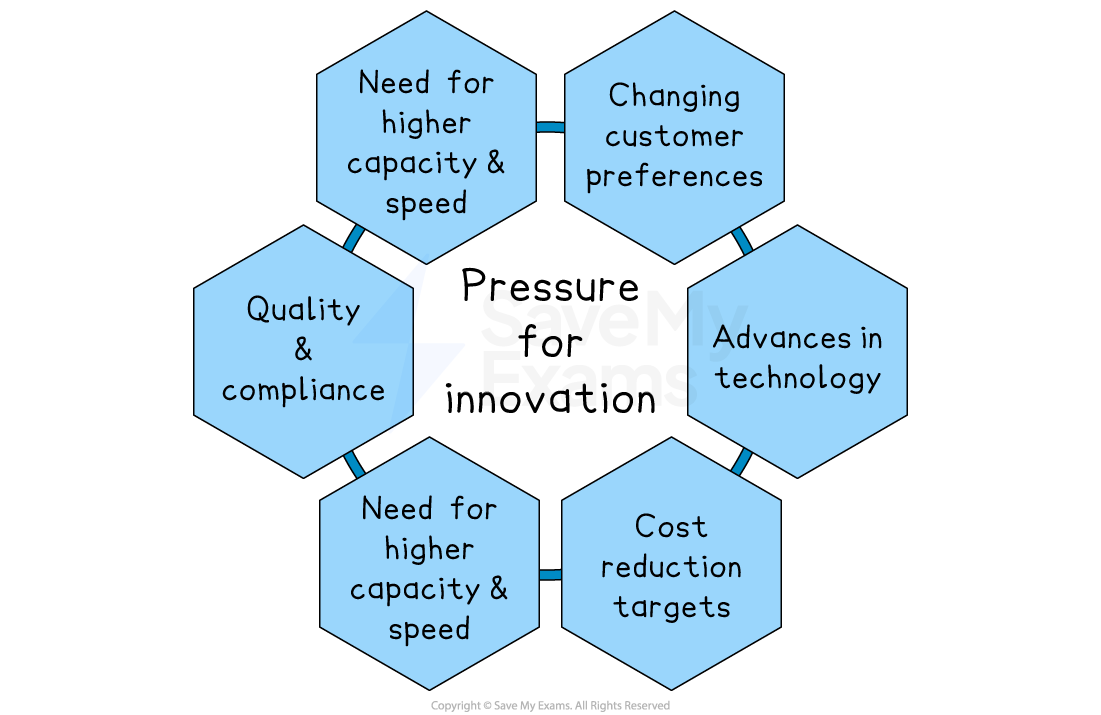The Value of Innovation (AQA A Level Business): Revision Note
Exam code: 7132
Why innovation is important
Innovation brings new products to customers and new processes that can lead to greater business efficiency
Incremental and disruptive innovation
Incremental innovation | Disruptive innovation |
|---|---|
|
|
 |  |
|
|
Types of innovation
Product innovation means creating a new good or service, or making a clear, valuable improvement to an existing one so that it meets customer needs more effectively than before
Examples include adding new features, better materials or a greener design
Process innovation is the introduction of new or significantly improved ways of making, delivering, or supporting a product or service that increase efficiency, cut costs or raise quality
This may include new equipment, software, production methods or workflow designs
Innovation helps businesses to:
Keep ahead of competitors
Introducing new or improved products gives customers a clear reason to choose one firm over another
Updating production methods can also lower prices or raise quality, helping a business stay competitive in fast-moving markets
Improve profits through cost savings and added value
Process innovations (for example, better software, automation, or energy-efficient equipment) reduce waste and labour time, cutting the cost of each unit made
Product innovations can justify higher selling prices or create premium versions, increasing profit earned on every sale
Reach new customers and markets
Developing products with different features, sizes, or environmental benefits, and finding better ways to make or deliver them allows a business to serve groups it could not reach before
A wider customer base spreads risk and supports steady growth over time
Pressures on firms to innovate

Intensifying competition
When rival firms launch new models or features, a business risks losing customers unless it responds with fresh ideas of its own
Changing customer preferences
Shifts in lifestyle, fashion or concerns, such as demand for eco-friendly packaging or healthier ingredients, force firms to update products to stay relevant
Advances in technology
Breakthroughs in materials, digital tools, or production processes, such as 3D printing or AI, open the door to products that are smarter, faster, or cheaper than older versions
This puts pressure on businesses to adopt the latest technology too
Cost reduction targets
Rising labour, energy, or material costs encourage businesses to find quicker, less wasteful methods so each unit can be produced more cheaply
Need for higher capacity and speed
Growing demand or shorter delivery expectations (for example, next-day shipping) require faster production lines, better logistics software, or automation to handle larger volume without delays
Quality and compliance
Stricter quality standards and regulations, such as food safety rules or data protection laws, push firms to adopt new systems that guarantee consistent output and meet legal obligations
How do firms innovate?
Businesses can encourage innovation by making small daily improvements (Kaizen), running formal research projects (R & D), encouraging employees to act like entrepreneurs (intrapreneurship), and studying top performers to copy best practice (benchmarking)
Kaizen | Research & development (R&D) |
|---|---|
|
|
|
|
Intrapreneurship | Benchmarking |
|
|
|
|
Case Study
Unilever UK: Innovation in Action
Business Overview
Unilever is one of the UK’s largest FMCG (Fast-Moving Consumer Goods) companies, owning brands such as Dove, Lynx, and Persil. With R&D hubs in Port Sunlight and a strong culture of employee-led innovation, Unilever has become a leader in sustainable and customer-focused innovation

Kaizen
In Unilever’s Port Sunlight factory, frontline employees run daily “improvement huddles," suggesting tweaks to reduce waste or streamline packaging lines
Research & Development
The UK R&D team helped launch the compressed deodorant can, using 50% less gas and metal—an eco-friendly innovation based on scientific aerosol research
Intrapreneurship
Through its internal “Foundry” programme, staff pitch start-up-style ideas. One success: an app that helps consumers reduce food waste with Unilever products
Benchmarking
Unilever regularly benchmarks supply chain emissions and packaging performance against top competitors like P&G and Nestlé to drive sustainability goals
Results
The compressed can design saved 15,000 tonnes of CO₂ annually
Continuous improvement from employee Kaizen ideas led to a 12% increase in line efficiency at one UK plant
Intrapreneur-led digital tools increased brand engagement and consumer loyalty
Examiner Tips and Tricks
Big R&D budgets help, but a culture that allows experimentation often turns smaller research spending into breakthroughs
Protecting innovation and intellectual property
Intellectual property rights (IPRs) protect inventions, creative works and some specialised processes from being copied
This protection encourages spending on research and development
Possessing important IPRs can provide a valuable competitive advantage
There are three main types of IPRs
Copyrights
Patents
Trademarks
Comparison of intellectual property rights
Copyrights
Copyright grants the creator of an original work exclusive rights to its use and distribution for a limited time
It applies to creative, intellectual and artistic works including books, song lyrics, paintings and film scripts
Protection begins when a piece of work is created
It does not need to be formally registered
The © symbol may be applied to the work
Permission needs to be sought from the copyright holder to use the work
In 2001 Dyson successfully sued Hoover for infringement of their bagless dual cyclone vacuum design
Patents
Patents give a business or inventor exclusive rights to make, use and sell an invention for a specified period
A detailed description including drawings/diagrams is filed with the government patent office
Patents provide inventors with a legal monopoly for a limited time
This allows them to control the use of their inventions and potentially profit from them
In 2022 Converse won a patent case against fashion designer Steve Madden's similar Winnona Sneaker design
Enforcing property rights
IPRs can provide protection but pursuing breaches can be expensive, as court costs can be significant if a complaint is lost
Many businesses prefer to settle IPR disputes out of court
Arrangements to cease and desist from illegal use of designs, processes or trademarks
Agreeing compensation payments

Unlock more, it's free!
Did this page help you?